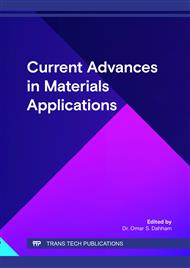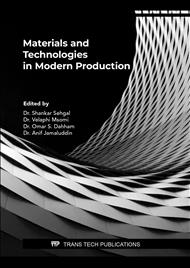[1]
M. Huurman, L.T. Mo, M.F. Woldekidan, S.P. Wub and A.A.A. Molenaar, Investigation into material development and optimization of improved raveling resistant porous asphalt concrete, Journal of Materials and Design. 31 (2010) 3194–3206.
DOI: 10.1016/j.matdes.2010.02.026
Google Scholar
[2]
R. Moraes, R. Velasquez and H.U. Bahia, Measuring the Effect of Moisture on Asphalt-Aggregate Bond with the Bitumen Bond Strength Test, Transportation Research Record: Journal of the Transportation Research Board. 2209(1) (2011) 70–81.
DOI: 10.3141/2209-09
Google Scholar
[3]
Y. H. Abed, The Deformation Strength Characterization of a Thin Film Bitumen Material, Ph.D. thesis, Mustansiriayah University, Baghdad, Iraq (2020).
Google Scholar
[4]
L. Guangyang, W. Hong, Y. Hong, Y. Jinyuan, Y. Zhuoqing and D. Guifu, Research in the improvement of wettability of micro-structure in patterned electro deposition, American Journal of Nanotechnology. 1(1) (2010) 23-31.
DOI: 10.3844/ajnsp.2010.23.31
Google Scholar
[5]
D. Cheng, Surface Free Energy of Asphalt-aggregate System and Performance Analysis of Asphalt Concrete Based on Surface Free Energy., Ph. D. Thesis, Texas A&M University, Texas, US (2002).
Google Scholar
[6]
D. Cheng, D.N. Little, R.L. Lytton and J.C. Holste, Use of surface free energy properties of the asphalt-aggregate system to predict moisture damage potential. J. Assoc. Asphalt Paving Technol. 71 (2002) 59-88.
Google Scholar
[7]
J. Wei and Dong Ying, Study on Surface Free Energy of Asphalt Aggregate and Moisture Diffusion in Asphalt., Ph.D. Thesis, China University of Petroleum, China(2008).
Google Scholar
[8]
G. Xu and H. Wang, Study of cohesion and adhesion properties of asphalt concrete with molecular dynamics simulation."Comput. Mater. Sci. 112 (2016) 161– 169.
DOI: 10.1016/j.commatsci.2015.10.024
Google Scholar
[9]
J. S. Chen and C. C. Huang, Fundamental Characterization of SBS-Modified Asphalt Mixed with Sulfur." Journal of applied polymer science. 103(5) (2006) 2817-2825.
DOI: 10.1002/app.24621
Google Scholar
[10]
K. Kanitpong and H. Bahia, Role of Adhesion and Thin Film Tackiness of Asphalt Binders in Moisture Damage of HMA, Journal of the Association of Asphalt Paving Technologist. 72 (2003) 611-642.
Google Scholar
[11]
H.U. Bahia, F. Canestrari, F. Cardone, A. Graziani, and F.A. Santagata, Adhesive and Cohesive Properties of Asphalt- Aggregate Systems Subjected to Moisture Damage, Road Materials and Pavement Design. 11(1) (2010) 11-32.
DOI: 10.1080/14680629.2010.9690325
Google Scholar
[12]
C.R. Marek and M. Herrin, Tensile behavior and failure characteristics of asphalt cement in thin films, Journal of the Association of Asphalt Paving Technologists.37 (1967) 386-421.
Google Scholar
[13]
K. Kanitpong and H. Bahia, Evaluation of the Roles of Adhesion and Cohesion Properties of Asphalt Binders in Moisture Damage of HMA." Ph.D. Thesis, University of Wisconsin – Madison Department of Civil and Environmental Engineering, US (2004).
Google Scholar
[14]
K. Kanitpong and H. Bahia, Relating adhesion and cohesion of asphalt to the effect of moisture on laboratory performance of asphalt mixtures, Journal of the Transportation Research Board. 1901(1) (2005) 33-34.
DOI: 10.1177/0361198105190100105
Google Scholar
[15]
A. R. Copeland, Influence of moisture on bond strength of asphalt-aggregate systems, Ph.D. Thesis, Vanderbilt University, Nashville, Tenn.US, (2007).
Google Scholar
[16]
E. A. Masad, J. E. Howson, A. Bhasin, S. Caro and D.N. Little, Relationship of Ideal Work of Fracture to Practical Work of Fracture: Background and Experimental Results, Journal of the Association of Asphalt Paving Technologists, 79 (2010) 81–118.
Google Scholar
[17]
A. H. Abed, Enhanced aggregate-asphalt adhesion and stability of local hot mix asphalt, Engineering and Technical Journal. 29(10) (2011) 2044–(2059).
Google Scholar
[18]
J. E. Howson, Relationship between surface energy and total work of fracture of asphalt binder and asphalt binder- aggregate interfacial, Ph.D. Thesis, University of Texas A&M, US,(2011).
Google Scholar
[19]
ASTM, Determining the Rheological Properties of Asphalt Binder Using a Dynamic Shear Rheometer., D7175 – 08, ASTM, Philadelphia, Pa., (2015).
Google Scholar
[20]
Y.H. Abed, Y. A. Khudhair, and A. H. Alhaddad , Discrepancies in Rheological Properties of Modified Asphalt Cement, IOP Conf. Series: Materials Science and Engineering, The International Conference on Engineering and Advanced Technology (ICEAT 2020), Assiut, Egypt. (2020)12-29.
DOI: 10.1088/1757-899x/870/1/012029
Google Scholar
[21]
F. M. Fowkes, Attractive Forces at Interfaces." industrial and Engineering Chemistry Research. 56(12) (1964) 40–52.
DOI: 10.1021/ie50660a008
Google Scholar
[22]
D. K. Owens and R. C. Wendt, Estimation of the Surface Free Energy of Polymers, J. Appl. Polym. Sci. 13(8) (1969) (1969) 1741–1747.
DOI: 10.1002/app.1969.070130815
Google Scholar



